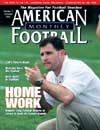AMERICAN FOOTBALL MONTHLY THE #1 RESOURCE FOR FOOTBALL COACHES
Article CategoriesAFM Magazine
|
On the CircuitNorth Dakota uses circuit drills to develop top-notch defensesby: Kyle Schweigert Defensive Coordinator/Assistant Head Coach, University of North Dakota © More from this issue At the University of North Dakota, we have one major goal for our defense to attain each season. That goal is to lead the North Central Conference in fewest points allowed. This is not an easy task in one of the most balanced and powerful Division II conferences in the country. Yet we have reached our goal of allowing the fewest points in our league in six of the last nine seasons. During six of the last seven seasons, we have also been first or second in our conference in total defense. While we are proud of the fact that we have not allowed many yards when compared to other teams in our league, we are most proud to be the team that has allowed the fewest points in league play during six of the last nine seasons. Our defensive staff, like all coaching staffs, feels that we must be great at the fundamentals to be able to reach our seaso....The full article can only be seen by subscribers.
|
|
|||||||
| HOME |
MAGAZINE |
SUBSCRIBE | ONLINE COLUMNISTS | COACHING VIDEOS |
Copyright 2025, AmericanFootballMonthly.com
All Rights Reserved





